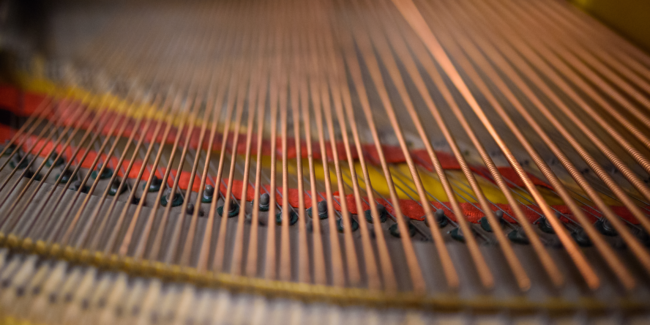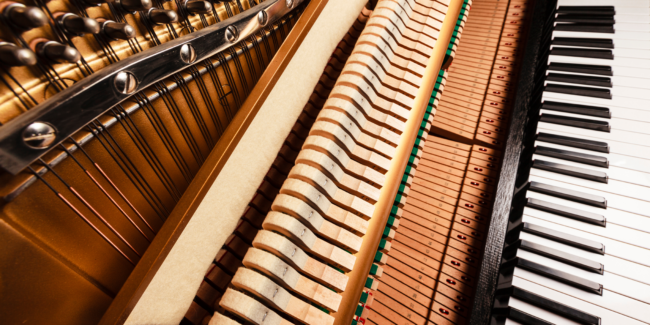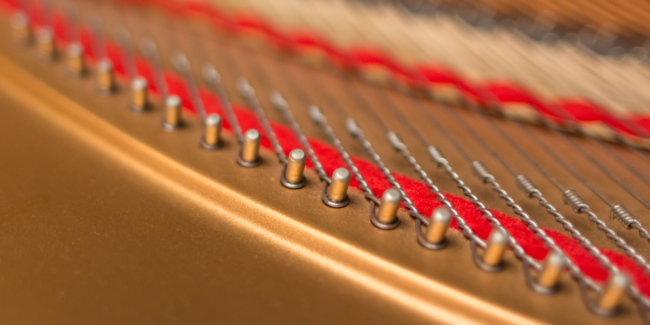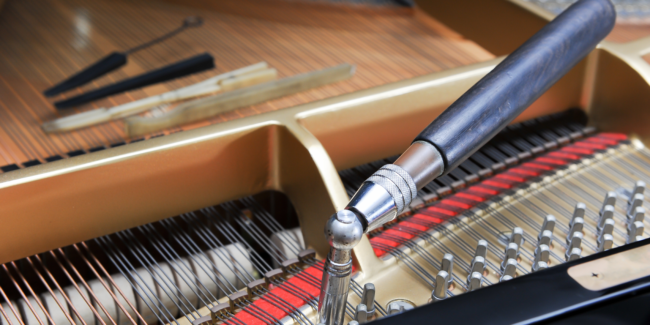Everything You Must Know About Piano Strings

What are piano strings for? How many does a piano have? In this article, you’ll learn everything you need to know about piano strings.
Pianos have their roots in the keyboard and percussion family tree. While there certainly is some hammer-action, the sound source comes from precisely coiled strings.
Piano designs are complex, to say the least. Everything from setting them up to repairing them is a delicate process — strings are no exception.
Let’s familiarize you with everything you need about piano strings.
What are piano strings for?
Piano strings play a fundamental role in generating sounds. Just like a guitar, the strings are the source of the sound that emanates from the instrument. Instead of fingers, hammers striking the strings produce vibrations.
With an array of keys and notes, there are different widths of wire that instrument-makers incorporate in the design.

How many strings does a piano have?
The number of strings in a given instrument varies. Pianos are complex and can come with unique features depending on who makes them. However, there are generally 230 strings on a piano.
The tenor and treble (two-thirds) strings are plain drawn steel with a carbon content of more than 0.80% — giving it high tensile strength. In the last third, we use copper wound bass strings.
The wires are also malleable, making them ideal for wrapping around tuning pins without breaking.
Piano strings gradually become longer and thicker as we move down the piano – the thinner the string, the higher the pitch of the note. Although, the differences in size are so minute that they’re hard to see.
The bass strings, on the other hand, vary quite a bit. The steel core is wrapped in copper, giving them a greater mass.
While varying wire lengths and densities affect the sound, finding and creating the most pleasing pitches requires setting the strings to the proper tension.
Standing waves.
The piano is a beautiful instrument thanks to scientific and mathematical ingenuity, and determining the ideal string gauge is no exception.
Gauging strings to the proper tension was made possible by Marin Mersenne (1588-1648). Mersenne’s Laws describe the frequency of oscillation on a stretched wire.
However, the formula was perfected by a mathematician named Brook Taylor. We continue to use the Mersenne-Taylor formula to calculate the frequency of a vibrating string today.
If you’re curious about standing waves and want to understand them in greater detail, check out this youtube video.
With the advent of technology, computers now assist us in tuning pianos, although the formula is still of fundamental importance when gauging strings.
Strings & notes.
Part of the sound generating mechanism includes a system of parts that lock-in and stretch out the wire.
The strings are coiled on both ends. There is a hitch pin on one side and a tuning pin on the other. A bridge and agraffe bearing on the other side are carefully placed after the hitch pin. The string between these points is known as speaking length, and the section of string between the hitch pin/bridge and the agraffe/tuning pin is called the back and front duplexes.

A single key will also strike more than one string. For bass notes, keys strike two wires, and for the lowest bass notes, only a single string. Striking multiple strings enriches the sounds and increases volume.
How to replace your piano strings.
Just like guitar strings, sometimes you have to replace your piano strings. However, a piano and a guitar are vastly different instruments, and so are the wires we use.
Manufacturers construct pianos with specific, delicate materials, and the oils from your hands can lead to faster degradation of your instrument. Before you start, make sure to put some gloves on.
Another thing to remember is to ensure that you have the correct replacement string. The width of your wire must be the same. The sound will be off if you don’t have the right string size.
You will need a dummy pin, coil lifter/string spacer, and a stringing crank to replace your string.

Once you have everything you need, you can start by:
- Remove the broken piano string. Cutting the wire at the v-bar makes removing the rest of the line much more manageable.
- Loosen the tuning pins so you can tighten the new string (enough for three coils).
- Feed one end of the wire under the v-bar toward the left tuning pin, and insert it through the hole in the tuning pin.
- Create a bend (aka a becket) in the string to help it latch on to the pin.
- With your stringing crank, make two and a half tight coils on the pin (turning counterclockwise). Use your coil lifter to keep the string or coils in the correct position.
- Now that you have a coil, hook the wire into the bridge pins.
- Wrap the string around the hitch pin, and give it a tight twist.
- Feed the string back through the v-bar and the second tuning pin.
- Measure three inches or 7.62 centimeters beyond the tuning pin and cut it at that point.
- Repeat steps “4” to “6” (make sure to leave enough slack for step “6”.
- Tighten the string.
Replacing the string is one thing; tuning it is another.
Check out Piano Tuning Essentials & DIY for tips on tuning your piano.
How much does it cost to replace a piano string?
Replacing a piano string is a delicate procedure. It requires specific tools, precise measurements, and a steady hand.
If you find that replacing your piano strings is too much work, or you want to make sure to do it properly, then you can always hire a professional.
The price for restringing a single piano wire can range from $20 to $100, depending on who you see. If you’re looking to replace the entire kit, the cost can range from $1000 to $10,000.
Piano strings are just part of the complex instrument we call the piano. Just like any other piece of the system, they require tuning, maintenance, and occasionally replacement.
Owning and playing the piano is an unfolding process, and so is learning how to play! If you’re looking for a way to optimize your piano lessons, try our Simply Piano app.









